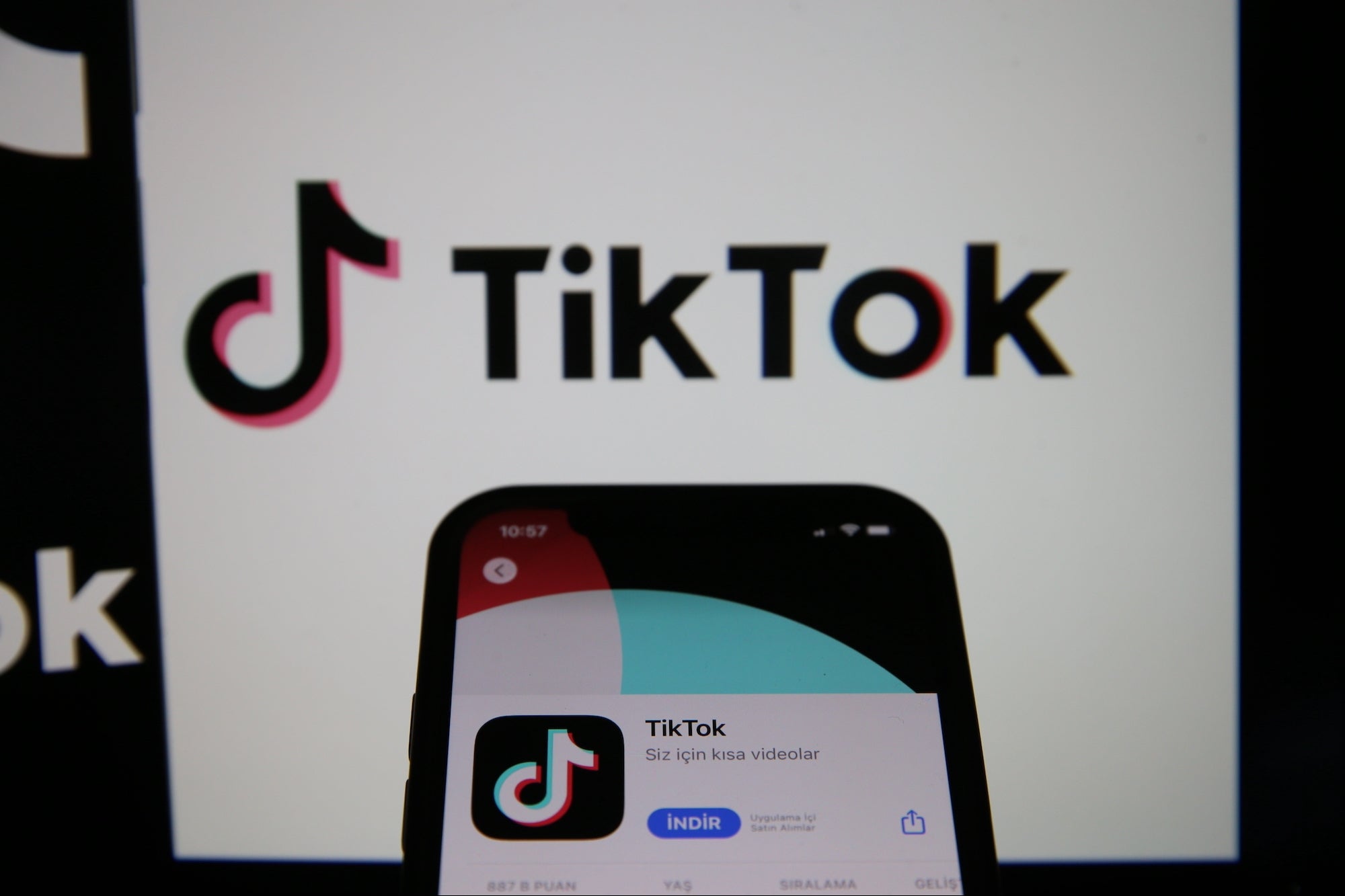AFFILIATE MARKETING
Are These 10 TikTok Side Hustles Right For You?

Many TikTok side hustles promise big money for little effort, but do they work?
To find out, I spoke with Daniella Flores, founder of ILikeToDabble.com. Daniella is a self-proclaimed side hustle queen who went from 0 to 12 income streams in 4 years, paying off over $40,000 of debt in the process.
Daniella broke down a bunch of trending TikTok side hustles on my podcast, The Side Hustle Show. You can hear our full interview below.
Here’s a summary of our conversation.
1. Drop-shipping
In drop-shipping, suppliers ship products directly to customers on your behalf.
Daniella dabbled in drop shipping, running a print-on-demand store on Etsy. Print-on-demand is a fulfillment process that drop-ships products to customers only after a sale goes through.
Using tools like Canva, Printify, and Printful, Daniella designed and sold custom products online for bachelorette parties, such as T-shirts, hoodies, and wine coolers.
Daniella preferred Etsy over other e-commerce sites because of its large user base. Users on Etsy also tend to search for niche products, so as long as you target the right keywords for your niche, you should be able to drive traffic to your store easily.
Etsy also charges as low as $0.20 for each item you list, and you won’t need to do as much marketing there as you would on Shopify and other online marketplaces.
But drop shipping is labor intensive. Daniella shut down their store after a few months, realizing how much customer service went into it.
Daniella’s advice on drop-shipping as a side hustle? Do SEO and talk to manufacturers first before launching in.
Related: 15 Easy Side Hustles From Home to Make Extra Money
2. Transcription
TikTok users have suggested transcribing as a side hustle by signing up for Rev — a speech-to-text service — then running the audio through a free speech recognition software like Dictation.io.
You’ll still have to double-check the quality of the transcriptions, but you can make $1 per finished-audio minute doing this side hustle. One TikTok user claims you can easily make $500 daily on Rev if you work eight hours daily.
But Daniella did some digging and found that some freelancers made as little as $100 a month on Rev. Many also worked eight hours a day — not exactly a side hustle.
Ultimately, Daniella thinks transcribing on platforms like Rev is a great side hustle for beginners but not for those who want to make real money on the side.
3. Low-content publishing
This involves uploading an almost blank book to Amazon and having the company print and ship it on your behalf.
Think journals, diaries, planners, sketchbooks, and notebooks. With these types of books, the value comes from how you’ve structured the mostly-blank pages and prompts and who you’re targeting as your customer.
For the most part, low-content publishing is marketed on TikTok as a shortcut for those who don’t have the expertise or the time to write and self-publish a 25,000-word book.
But as Daniella observed that most TikTok users who do low-content publishing never give distinct numbers or show anything on the back end. They often focus on the creation part, which seems easy enough until you have to sell the book on Amazon.
Low-content publishing on Amazon is a highly competitive space where people pretty much throw their products at the wall and see what sticks.
That’s why Tammie Chrin, a long-time Side Hustle Show listener, developed her method for creating branded books for businesses featuring their content. She calls it KDP (Kindle Direct Publishing) 4 B2B.
With this method, rather than rely solely on Amazon for sales, you go to existing businesses and create custom books for them that they can buy or gift to their customers.
4. Selling printables
You create the products on programs like Canva or Adobe Photoshop and market them to your target audience.
The best part? You don’t need to ship anything or meet anybody in person. As soon as someone buys your printable, all they need to do is download it.
TikTok users say this is a great source of passive income, but Daniella says that’s not entirely true. “You’re still a business. You have to provide customer service — all that fun stuff.”
And as with any online business, you probably won’t make much money doing this for the first few years.
Nonetheless, this side hustle can scale once you get the hang of it and don’t give up.
5. Naming companies
Do you have a knack for names?
Squadhelp is an innovative crowdsourcing platform for business names, tag lines, logos, and other similar marketing projects.
For just a few hundred bucks, a startup can submit a proposal to Squadhelp containing the details of their business plan and a request for crowdsourced naming ideas.
Once the proposal is processed, the startup can hold a naming contest on Squadhelp. Contests typically run for about a week and usually attract tons of user entries.
At the end of the contest, the startup chooses one name from the pool of entries, and the winner receives a minimum $100 prize. Some contests pay as high as $500.
The downside? Contests on Squadhelp typically attract hundreds of submissions, so your odds of winning are generally low.
6. Affiliate marketing
With affiliate marketing, you earn a commission on sales referred through your blog or website.
On TikTok, creators say they make as much as $2,000 daily in affiliate sales, even though the platform doesn’t allow users to add affiliate links to their videos.
Some of the ways users get around that are:
- upgrading to a business account
- putting affiliate links in their profile bio
- redirecting traffic to their other social media profiles
- using third-party tools like Linktree
- promoting discount codes in their videos
While affiliate marketing is a legit passive income generation strategy, Daniella says it only works for TikTok users with thousands of followers.
Also, affiliate marketing is a partnership between businesses, not a partnership between a business and any old TikTok user whose profile can disappear any day, Daniella explains,
Affiliate marketing can be a great side hustle, just not by itself.
7. Dumpster diving
Dumpster diving involves diving through dumpsters, usually at night, to discover what got thrown out. You might have better odds of scoring a good haul if you do this in an affluent part of town or check out dumpsters behind a strip mall near you.
You could even cut out the middleman completely and talk to your local stores to see if they’d be willing to give their trash to you directly.
Some TikTok users who dumpster-dive on the side report flipping their finds and selling them for a profit on eBay or Facebook marketplace. Meanwhile, those who are not so lucky share videos detailing their gross or unfruitful experience.
For those grossed out by dumpster diving, Daniella offers an alternative. Help people unpack after moving into a new home and offer to take things they don’t need.
Related: This Dumpster Diver Makes $5,000 a Month Salvaging Designer Items
8. Painting house numbers on the curb
This side hustle is arguably better suited for teenagers looking to earn cash over the summer. It requires no more than $50 to $100 worth of materials from Home Depot, some door-knocking, and half an hour of painting.
The only challenge with this is you can pretty quickly saturate your local market.
9. Niche cleaning businesses
Niche cleaning services are another side hustle especially popular among TikTok users.
Daniella shared how they watched a TikTok of kids washing people’s trash cans. The kids would power-wash up to 20 trash cans a day, earning around $2,000 weekly.
Aside from washing people’s trash cans, you could offer to clean yards, headlights, or gutters. Whatever it is, there’s probably someone out there who’d pay to have it cleaned.
Low-tech services like these also have little to no competition online, so you could easily create a brochure-style website or a Google Business Profile to find prospective customers.
10. Freelance content creation
In this side hustle, TikTok creators make videos for brands. First, they promote the company they eventually want to work with on their page for free. Once they build up an organic following around those brands, they’ll shoot the brands a message and ask if they’re interested in working together.
Rates vary per creator due to the contract negotiation involved, but creators are paid anywhere from $250-2000 per TikTok video, depending on the brand they’re working with.
But be warned: This side hustle requires lots of video know-how. “You have to learn about video marketing and short-form content marketing,” Daniella said.
AFFILIATE MARKETING
Site Traffic Down? Google Just Made Some Big Search Changes

Google is now doing the Googling for its expansive U.S. audience — and news publishers are facing potentially multi-billion-dollar consequences caused by the change.
Google announced on Tuesday that it is applying AI to high-impact elements of search, from AI summaries to pages of AI recommendations in clustered groups. AI summaries, which appear at the top of search results and neatly summarize content found across the web, started rolling out on Tuesday to all of Google’s 246 million unique U.S. users.
The AI summaries mean that websites across the board will get less traffic, as people simply search and read what the AI has generated without clicking on anything.
As newsrooms get less traffic and less money, their ability to create fresh content diminishes. At the same time, Google becomes less of a gateway to sources and more of a direct source Anastasia Kotsiubynska, Head of SEO at SE Ranking, shared with Entrepreneur.
“Most likely, there will still be misleading information in search results and hallucinations, and many users will probably use this information without double-checking,” Kotsiubynska cautioned.
Google I/O 2024 on May 14, 2024. (Photo by Christoph Dernbach/picture alliance via Getty Images)
Google’s search changes could cost websites $2 billion collectively; some could lose two-thirds of their traffic, according to data from media industry growth company Raptive.
“This will be catastrophic to our traffic, as marketed by Google to further satisfy user queries, leaving even less incentive to click through so that we can monetize our content,” Danielle Coffey, the chief executive of the News/Media Alliance, told CNN Business.
This is Search in the Gemini era. #GoogleIO pic.twitter.com/JxldNjbqyn
— Google (@Google) May 14, 2024
Google, a major tech company with over 90% of the global market share in search, can now frame search results however it wants with AI summaries, and pull from websites without guaranteeing site traffic or profit.
Related: Two Yale PhDs Are Trying to Make AI Hallucinate 10x Less
“AI Overviews relies on content creators’ intellectual property, which raises serious questions about compensation and fairness,” said Raptive in a statement.
Google does link to sites within its summary, citing its sources.
Unlike OpenAI, which has entered into deals with major publishers like Axel Springer and The Financial Times to compensate publishers for training AI on their articles and linking directly to them, Google has yet to publicly announce a similar deal with a major publication.
OpenAI has also earned the ire of some publishers, with the New York Times filing a lawsuit against the company over copyright grounds in December.
Google does have a $60 million deal with Reddit, announced in February, to train its AI on Reddit data.
AFFILIATE MARKETING
Carnival Cruise Line Installs Starlink Internet on Every Ship

It’s another massive milestone for SpaceX CEO Elon Musk.
On Tuesday, Carnival Cruises announced that 100% of its ships have officially installed high-speed internet from Musk’s Starlink.
The installation took place on 90-plus ships in Carnival’s global fleet and allows for more reliable Wi-Fi when onboard (especially during remote parts of the route) for passengers and helps the ship’s staff with improving “operational and communications capabilities,” per a release from Carnival.
Related: New Jersey Man Accused of Trafficking 675 Starlink Terminals
“Starlink has been a game-changer for the onboard connectivity experience our cruise lines deliver to their guests, and we’ve already seen a surge in guest satisfaction and positive feedback from the super-fast and reliable Wi-Fi service we provide onboard,” said Josh Weinstein, CEO of Carnival Corporation in a release. “We see this technology as a win-win-win – it provides our guests with more flexibility to stay as connected as they’d like on vacation, it allows our crew to stay in touch with friends and loved ones, and it enhances our onboard operational systems.”
The installment of Starlink on Carnival ships began in December 2022 and has now expanded to all of Carnival’s smaller companies, including Princess Cruises and Holland America Line.
Musk reposted the news with one word to share his sentiments: “Cool.”
— Elon Musk (@elonmusk) May 14, 2024
Royal Caribbean started installing Starlink on its ships in 2022 and as of February 2024, said that it was “currently in the process of upgrading more vessels” from VOOM internet to Starlink.
Carnival is coming off a strong Q1 2024, setting the record for first-quarter revenue at $5.4 billion, while bookings hit a record high — despite higher prices.
“This has been a fantastic start to the year. We delivered another strong quarter that outperformed guidance on every measure, while concluding a monumental wave season that achieved all-time high booking volumes at considerably higher prices,” Weinstein said at the time. “These results are a continuation of the strong demand we have been generating across our brands and all core deployments, leading to an upward revision of full year expectations by more than a point of incremental yield improvement and setting us up nicely to deliver a nearly double-digit improvement in net yields.”
Carnival was up nearly 41% year over year as of Tuesday afternoon.
SOCIAL
12 Proven Methods to Make Money Blogging in 2024

 This is a contributed article.
This is a contributed article.
The world of blogging continues to thrive in 2024, offering a compelling avenue for creative minds to share their knowledge, build an audience, and even turn their passion into profit. Whether you’re a seasoned blogger or just starting, there are numerous effective strategies to monetize your blog and achieve financial success. Here, we delve into 12 proven methods to make money blogging in 2024:
1. Embrace Niche Expertise:
Standing out in the vast blogosphere requires focus. Carving a niche allows you to cater to a specific audience with targeted content. This not only builds a loyal following but also positions you as an authority in your chosen field. Whether it’s gardening techniques, travel hacking tips, or the intricacies of cryptocurrency, delve deep into a subject you’re passionate and knowledgeable about. Targeted audiences are more receptive to monetization efforts, making them ideal for success.
2. Content is King (and Queen):
High-quality content remains the cornerstone of any successful blog. In 2024, readers crave informative, engaging, and well-written content that solves their problems, answers their questions, or entertains them. Invest time in crafting valuable blog posts, articles, or videos that resonate with your target audience.
- Focus on evergreen content: Create content that remains relevant for a long time, attracting consistent traffic and boosting your earning potential.
- Incorporate multimedia: Spice up your content with captivating images, infographics, or even videos to enhance reader engagement and improve SEO.
- Maintain consistency: Develop a regular publishing schedule to build anticipation and keep your audience coming back for more.
3. The Power of SEO:
Search Engine Optimization (SEO) ensures your blog ranks high in search engine results for relevant keywords. This increases organic traffic, the lifeblood of any monetization strategy.
- Keyword research: Use keyword research tools to identify terms your target audience searches for. Strategically incorporate these keywords into your content naturally.
- Technical SEO: Optimize your blog’s loading speed, mobile responsiveness, and overall technical aspects to improve search engine ranking.
- Backlink building: Encourage other websites to link back to your content, boosting your blog’s authority in the eyes of search engines.
4. Monetization Magic: Affiliate Marketing
Affiliate marketing allows you to earn commissions by promoting other companies’ products or services. When a reader clicks on your affiliate link and makes a purchase, you get a commission.
- Choose relevant affiliates: Promote products or services that align with your niche and resonate with your audience.
- Transparency is key: Disclose your affiliate relationships clearly to your readers and build trust.
- Integrate strategically: Don’t just bombard readers with links. Weave affiliate promotions naturally into your content, highlighting the value proposition.
5. Display Advertising: A Classic Approach
Display advertising involves placing banner ads, text ads, or other visual elements on your blog. When a reader clicks on an ad, you earn revenue.
- Choose reputable ad networks: Partner with established ad networks that offer competitive rates and relevant ads for your audience.
- Strategic ad placement: Place ads thoughtfully, avoiding an overwhelming experience for readers.
- Track your performance: Monitor ad clicks and conversions to measure the effectiveness of your ad placements and optimize for better results.
6. Offer Premium Content:
Providing exclusive, in-depth content behind a paywall can generate additional income. This could be premium blog posts, ebooks, online courses, or webinars.
- Deliver exceptional value: Ensure your premium content offers significant value that justifies the price tag.
- Multiple pricing options: Consider offering tiered subscription plans to cater to different audience needs and budgets.
- Promote effectively: Highlight the benefits of your premium content and encourage readers to subscribe.
7. Coaching and Consulting:
Leverage your expertise by offering coaching or consulting services related to your niche. Readers who find your content valuable may be interested in personalized guidance.
- Position yourself as an expert: Showcase your qualifications, experience, and client testimonials to build trust and establish your credibility.
- Offer free consultations: Provide a limited free consultation to potential clients, allowing them to experience your expertise firsthand.
- Develop clear packages: Outline different coaching or consulting packages with varying time commitments and pricing structures.
8. The Power of Community: Online Events and Webinars
Host online events or webinars related to your niche. These events offer valuable content while also providing an opportunity to promote other monetization avenues.
- Interactive and engaging: Structure your online events to be interactive with polls, Q&A sessions, or live chats. Click here to learn more about image marketing with Q&A sessions and live chats.
9. Embrace the Power of Email Marketing:
Building an email list allows you to foster stronger relationships with your audience and promote your content and offerings directly.
- Offer valuable incentives: Encourage readers to subscribe by offering exclusive content, discounts, or early access to new products.
- Segmentation is key: Segment your email list based on reader interests to send targeted campaigns that resonate more effectively.
- Regular communication: Maintain consistent communication with your subscribers through engaging newsletters or updates.
10. Sell Your Own Products:
Take your expertise to the next level by creating and selling your own products. This could be physical merchandise, digital downloads, or even printables related to your niche.
- Identify audience needs: Develop products that address the specific needs and desires of your target audience.
- High-quality offerings: Invest in creating high-quality products that offer exceptional value and user experience.
- Utilize multiple platforms: Sell your products through your blog, online marketplaces, or even social media platforms.
11. Sponsorships and Brand Collaborations:
Partner with brands or businesses relevant to your niche for sponsored content or collaborations. This can be a lucrative way to leverage your audience and generate income.
- Maintain editorial control: While working with sponsors, ensure you retain editorial control to maintain your blog’s authenticity and audience trust.
- Disclosures are essential: Clearly disclose sponsored content to readers, upholding transparency and ethical practices.
- Align with your niche: Partner with brands that complement your content and resonate with your audience.
12. Freelancing and Paid Writing Opportunities:
Your blog can serve as a springboard for freelance writing opportunities. Showcase your writing skills and expertise through your blog content, attracting potential clients.
- Target relevant publications: Identify online publications, websites, or magazines related to your niche and pitch your writing services.
- High-quality samples: Include high-quality blog posts from your site as writing samples when pitching to potential clients.
- Develop strong writing skills: Continuously hone your writing skills and stay updated on current trends in your niche to deliver exceptional work.
Conclusion:
Building a successful blog that generates income requires dedication, strategic planning, and high-quality content. In today’s digital age, there are numerous opportunities to make money online through blogging. By utilizing a combination of methods such as affiliate marketing, sponsored content, and selling digital products or services, you can leverage your blog’s potential and achieve financial success.
Remember, consistency in posting, engaging with your audience, and staying adaptable to trends are key to thriving in the ever-evolving blogosphere. Embrace new strategies, refine your approaches, and always keep your readers at the forefront of your content creation journey. With dedication and the right approach, your blog has the potential to become a valuable source of income and a platform for sharing your knowledge and passion with the world, making money online while doing what you love.
Image Credit: DepositPhotos
-

 SEO7 days ago
SEO7 days agoHow to Use Keywords for SEO: The Complete Beginner’s Guide
-

 MARKETING5 days ago
MARKETING5 days agoAdvertising on Hulu: Ad Formats, Examples & Tips
-

 MARKETING2 days ago
MARKETING2 days ago18 Events and Conferences for Black Entrepreneurs in 2024
-

 WORDPRESS5 days ago
WORDPRESS5 days agoBest WordPress Plugins of All Time: Updated List for 2024
-

 MARKETING6 days ago
MARKETING6 days agoUpdates to data build service for better developer experiences
-

 WORDPRESS6 days ago
WORDPRESS6 days agoShopify Could Be Undervalued Based On A Long-Term Horizon
-

 MARKETING7 days ago
MARKETING7 days agoThe Ultimate Guide to Email Marketing
-

 PPC6 days ago
PPC6 days agoLow Risk, High Reward YouTube Ads alexking















